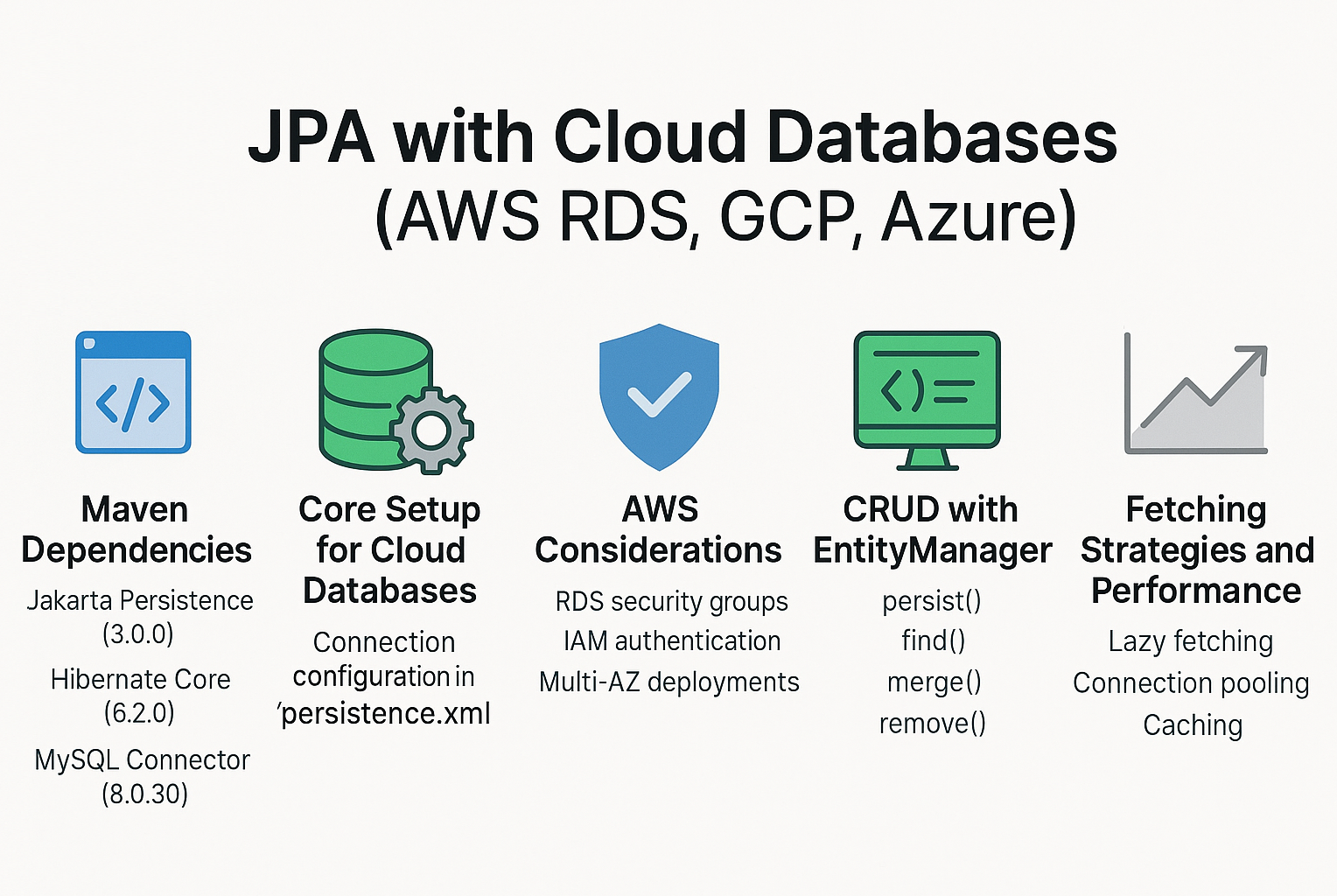Enterprises are increasingly adopting cloud databases for scalability, availability, and reduced operational overhead. JPA (Jakarta Persistence API) integrates seamlessly with cloud databases such as AWS RDS, Google Cloud SQL, and Azure SQL Database.
Using JPA with cloud databases provides developers with the same ORM abstraction they are used to, but with the added benefits of cloud-native features like automated backups, replication, and failover.
Think of cloud databases like power stations for your application: you don’t build the infrastructure yourself, but you still need the right connections (JPA configuration) to use the power effectively.
Core Setup for Cloud Databases
Maven Dependencies
<dependency>
<groupId>jakarta.persistence</groupId>
<artifactId>jakarta.persistence-api</artifactId>
<version>3.0.0</version>
</dependency>
<dependency>
<groupId>org.hibernate.orm</groupId>
<artifactId>hibernate-core</artifactId>
<version>6.2.0.Final</version>
</dependency>
<dependency>
<groupId>mysql</groupId>
<artifactId>mysql-connector-java</artifactId>
<version>8.0.30</version>
</dependency>
Connecting JPA to AWS RDS
persistence.xml
<persistence xmlns="https://jakarta.ee/xml/ns/persistence" version="3.0">
<persistence-unit name="awsRdsPU">
<provider>org.hibernate.jpa.HibernatePersistenceProvider</provider>
<properties>
<property name="jakarta.persistence.jdbc.driver" value="com.mysql.cj.jdbc.Driver"/>
<property name="jakarta.persistence.jdbc.url" value="jdbc:mysql://mydb.xxxxxx.rds.amazonaws.com:3306/mydb"/>
<property name="jakarta.persistence.jdbc.user" value="admin"/>
<property name="jakarta.persistence.jdbc.password" value="mypassword"/>
<property name="hibernate.hbm2ddl.auto" value="update"/>
<property name="hibernate.show_sql" value="true"/>
</properties>
</persistence-unit>
</persistence>
AWS Considerations
- Ensure RDS security groups allow inbound traffic.
- Use IAM authentication for secure connections.
- Apply multi-AZ deployments for resilience.
Connecting JPA to GCP Cloud SQL
<persistence-unit name="gcpCloudSqlPU">
<provider>org.hibernate.jpa.HibernatePersistenceProvider</provider>
<properties>
<property name="jakarta.persistence.jdbc.driver" value="com.mysql.cj.jdbc.Driver"/>
<property name="jakarta.persistence.jdbc.url" value="jdbc:mysql://google/mydb?cloudSqlInstance=myproject:region:instance&socketFactory=com.google.cloud.sql.mysql.SocketFactory"/>
<property name="jakarta.persistence.jdbc.user" value="root"/>
<property name="jakarta.persistence.jdbc.password" value="mypassword"/>
</properties>
</persistence-unit>
GCP Considerations
- Use Cloud SQL Auth Proxy for secure connections.
- Enable connection pooling via HikariCP.
- Monitor queries with Cloud SQL Insights.
Connecting JPA to Azure SQL
<persistence-unit name="azureSqlPU">
<provider>org.hibernate.jpa.HibernatePersistenceProvider</provider>
<properties>
<property name="jakarta.persistence.jdbc.driver" value="com.microsoft.sqlserver.jdbc.SQLServerDriver"/>
<property name="jakarta.persistence.jdbc.url" value="jdbc:sqlserver://myserver.database.windows.net:1433;databaseName=mydb;encrypt=true;trustServerCertificate=false;loginTimeout=30;"/>
<property name="jakarta.persistence.jdbc.user" value="azureuser"/>
<property name="jakarta.persistence.jdbc.password" value="mypassword"/>
</properties>
</persistence-unit>
Azure Considerations
- Use Azure Managed Identity instead of passwords where possible.
- Enable geo-replication for high availability.
- Monitor with Azure Application Insights.
Example Entity
@Entity
@Table(name = "customers")
public class Customer {
@Id
@GeneratedValue(strategy = GenerationType.IDENTITY)
private Long id;
private String name;
private String email;
// Getters and Setters
}
CRUD with EntityManager
@Stateless
public class CustomerService {
@PersistenceContext
private EntityManager em;
public void createCustomer(Customer c) {
em.persist(c);
}
public Customer findCustomer(Long id) {
return em.find(Customer.class, id);
}
public Customer updateCustomer(Customer c) {
return em.merge(c);
}
public void deleteCustomer(Long id) {
Customer c = em.find(Customer.class, id);
if (c != null) em.remove(c);
}
}
Querying in Cloud JPA Applications
List<Customer> customers = em.createQuery("SELECT c FROM Customer c WHERE c.email LIKE :email", Customer.class)
.setParameter("email", "%gmail.com")
.getResultList();
Fetching Strategies and Performance
- Use Lazy fetching to reduce network overhead.
- Implement connection pooling (HikariCP recommended).
- Cache frequently accessed data with second-level cache.
- Monitor network latency since cloud DBs may add extra hops.
Real-World Use Cases
- Banking Apps: Use AWS RDS for transactional workloads.
- E-Commerce: Deploy GCP Cloud SQL with read replicas for analytics.
- Enterprise SaaS: Use Azure SQL with multi-region replication.
Common Pitfalls
- Hardcoding credentials: Always use secrets managers (AWS Secrets Manager, GCP Secret Manager, Azure Key Vault).
- Ignoring connection pooling: Leads to slow performance under load.
- Relying on eager fetching: Increases cloud database costs.
- Not monitoring query execution plans: Causes hidden inefficiencies.
Best Practices
- Use DTO projections for microservices communication.
- Keep transactions short-lived to avoid DB locks.
- Use Flyway or Liquibase for schema migrations.
- Encrypt connections with SSL/TLS.
- Monitor with cloud-native observability tools.
📌 JPA Version Notes
- JPA 2.0: Introduced Criteria API, Metamodel.
- JPA 2.1: Added stored procedures, entity graphs.
- Jakarta Persistence (EE 9/10/11): Migrated from
javax.persistencetojakarta.persistence, improving cloud-native integration.
Conclusion & Key Takeaways
- JPA works seamlessly with AWS RDS, GCP Cloud SQL, and Azure SQL.
- Ensure secure connections, pooling, and monitoring for production readiness.
- Avoid common pitfalls like eager fetching and hardcoded credentials.
- Combine JPA with cloud-native features for scalability and reliability.
FAQ
Q1: What’s the difference between JPA and Hibernate?
A: JPA is a specification; Hibernate is a popular implementation.
Q2: How does JPA handle the persistence context?
A: Like a register, it tracks all managed entities.
Q3: What are the drawbacks of eager fetching in JPA?
A: It loads unnecessary data, increasing latency and costs.
Q4: How can I solve the N+1 select problem with JPA?
A: Use JOIN FETCH, entity graphs, or batch fetching.
Q5: Can I use JPA without Hibernate?
A: Yes, with EclipseLink or OpenJPA.
Q6: What’s the best strategy for inheritance mapping in JPA?
A: Use SINGLE_TABLE for speed, JOINED for normalized data.
Q7: How does JPA handle composite keys?
A: With @EmbeddedId or @IdClass.
Q8: What changes with Jakarta Persistence?
A: Package migration to jakarta.persistence.
Q9: Is JPA suitable for microservices?
A: Yes, with DTOs, schema-per-service, and event-driven communication.
Q10: When should I avoid using JPA?
A: Avoid for analytics-heavy workloads where raw SQL or NoSQL may be better.
